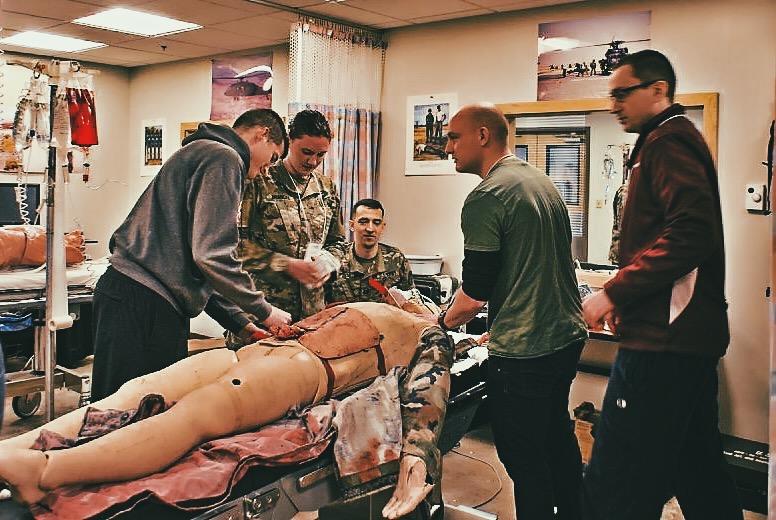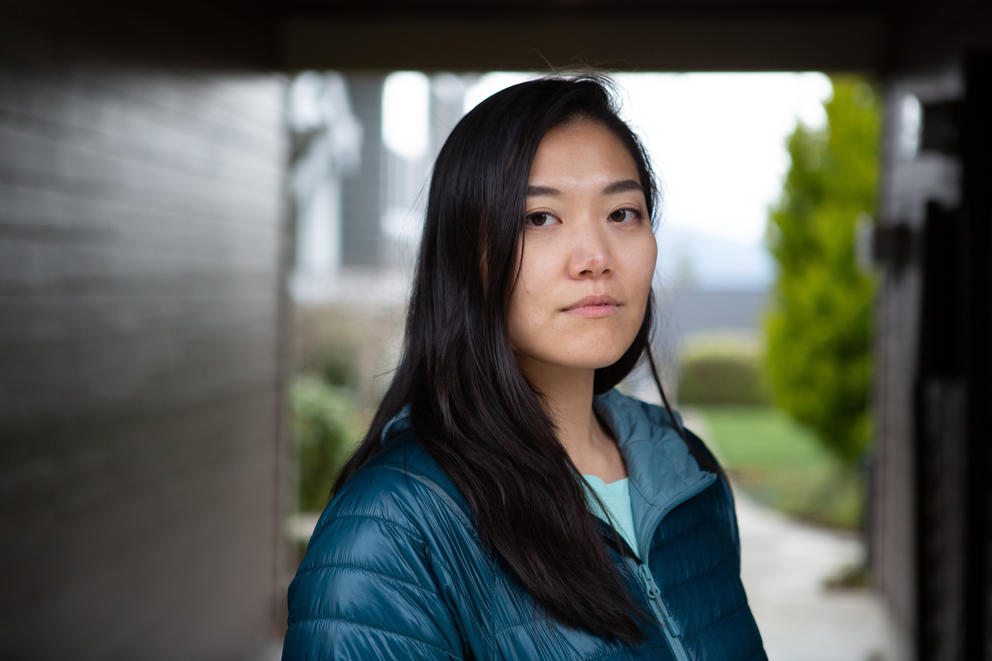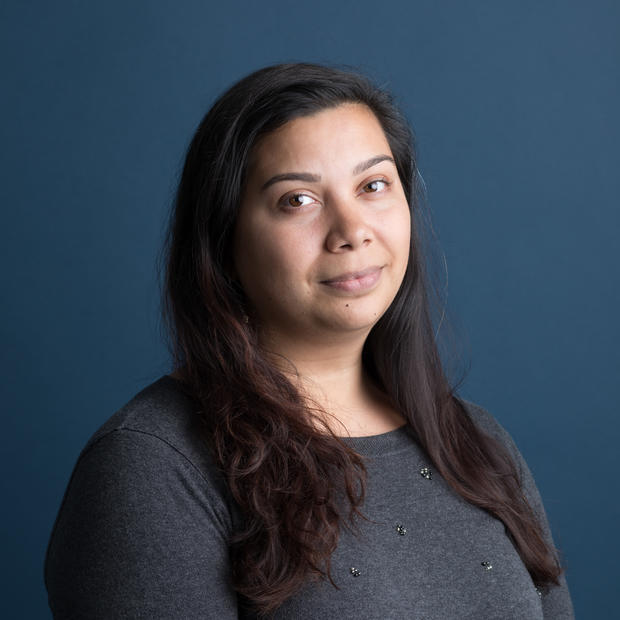Jeong, a third-year medical student at the University of Washington, recalled that the infectious disease doctors she was working with were cautious. "They were saying there's still so much we don't know about this virus, so we can't really say anything about the severity of it, or how this will end up affecting us," she said.
In early March, when she had moved on to her next rotation, this time in internal medicine at UW Medical Center, Jeong and her fellow medical students began to see impacts of the virus firsthand. At first, UW told them they could no longer see any patients with respiratory symptoms. Then, they weren't allowed to see any patients that would require the students to don personal protective equipment (PPE). One particular night, she realized the situation was rapidly deteriorating.
"I was on call and people were kind of streaming into our workroom and dropping different bombs. Like, 'We're running out of hand sanitizer.' 'We're running out of PPE.' 'Oh, there's a surge of patients in the ER; we're gonna run out of ICU room.' " That same night, when making her usual rounds on the ward to check on her patients, she noticed all the hand sanitizer bottles had disappeared from the hallways.
Finally, on March 15, Jeong awoke to an email from her chief resident saying all students on their internal medicine rotation at the UW Medical Center were not allowed to come back. Later that evening, a second email confirmed rotations were being suspended schoolwide.
It was a punch in the gut.
"Even being on the wards, I felt kind of guilty and helpless that there wasn't much I could do to help out in this situation," said Jeong. "And now that I was being formally pulled out, it really felt awful."
Many medical students like Jeong are finding themselves sidelined just as their future colleagues on the front lines are diving into the stress and uncertainty of pandemic response. With medical providers on the front lines falling ill or going into quarantine after exposure, many experts are predicting an imminent shortage of health care workers. The COVID-19 pandemic has health officials wondering: What role should medical students play during a global health crisis?
In Europe, where the virus has already sidelined thousands of medical professionals, several countries are turning to medical students to help ease the strain on their health care systems. Italy, the European country hardest hit by the outbreak, announced it was fast-tracking about 10,000 medical school graduates to put them to work months ahead of schedule, Newsweek reported. In the U.K., final-year medical students are graduating early, with some universities simplifying or canceling assessments to allow them to quickly register as doctors, according to the Guardian.
The U.S., which now has the most COVID-19 cases in the world, may be following suit. The New York Times reported last week that several medical schools in New York and Boston, including those at New York University, Tufts University and Boston University, would be offering early graduation to its fourth-year students. Others, such as Harvard Medical School, are considering doing the same.
None of Washington state's three medical schools has indicated similar plans. At UW Medicine, Suzanne Allen, vice dean for academic, rural and regional affairs, said the school is "constantly reevaluating the need" to graduate seniors early, though they aren't at this time.
Washington State University's newly founded medical school doesn't yet have seniors, given that its inaugural class started in 2017. Founding Dean John Tomkowiak said the school doesn't currently have plans to mobilize students, but that the topic is on officials' minds.
"It's a part of a national conversation," he said. "I was on a phone call with deans across the country recently, and certainly it was a topic that was brought up in consideration."
So far, like many other medical institutions nationally, Washington's medical schools have all moved their first- and second-year students' classes online. Meanwhile, all third- and fourth- year students have been pulled from working their clinical rotations in medical facilities. Initially, some schools tentatively indicated this would be for a few weeks. But on Friday, the UW informed medical students it would be suspending rotations until the beginning of summer quarter, June 29.
This is an unprecedented moment. "We are not aware of any U.S. medical school having to take such precautionary measures in recent history," said Alison Whelan, chief medical education officer at the American Association of Medical Colleges (AAMC), in a written statement. That means medical schools are charting new territory with their efforts to find suitable alternatives to keep students on track during the pandemic.
Traditionally, only the first half of medical school is classroom-based education. Students in their third and fourth year move to hands-on learning in clinical rotations. These are periods averaging four to six weeks, when students move through various specialties at hospitals and clinics their school partners with. The intent is to experience a variety of specialties — such as pediatrics, surgery, psychiatry and family medicine — to help students decide which field they'd like to enter.
During rotations, students are under the supervision and guidance of a more senior physician. But they often carry significant responsibilities, including interacting directly with patients and performing basic medical procedures. They may help out with physical examinations, diagnoses and treatment plans.
"Students are kind of the tertiary component of the health care team," after physicians and residents, said Michael Lawler, president of Pacific Northwest University of Health Sciences (PNWU), a private university based in Yakima, and the third medical school in the state.
That means that removing students from clinical settings can potentially put more of a strain on residents, who are already feeling an increased workload because of COVID-19.
The limits of an online medical education
"My friends who are third years all said that they understood why" the decision to pull students was made, said Arianna Delsman, a second-year medical student at Washington State.

"Definitely, it's important to both protect ourselves and our family and friends' health, but also to keep from becoming a vector in our community. But it's stressful because for third years, their entire learning experience is in the clinic," she explained.
The rapid changes and uncertainty of the situation has left some students concerned that they will feel "a little underprepared to graduate" and at a disadvantage entering into the workforce, said Laura Roberson, a second-year medical student at PNWU.
Schools across the country are scrambling to adjust their curriculum in response to COVID-19, and medical schools are no exception. But at a time when social distancing is the new normal, a profession that by definition requires hands-on learning and patient interaction presents a particular set of educational challenges.
Washington medical schools are working to substitute in-person clinical training with online materials, but it's far from a comparable experience.
"I've had the privilege of doing a surgical rotation already," said Samuel Billingslea, now in his third year at PNWU. "But some of my classmates talk to me about their online surgical rotation, or their online OB rotation where they don't deliver a baby or where they can never examine a patient ... [that] is to me a significant disservice."
"There really is not a substitute for doing your clinical rotation," acknowledged Allen, the UW Medicine vice dean. "They can do some education online. But ... they need to spend time seeing patients."
At this time, however, schools felt they had little choice but to remove students.
"Many of our clinical partners were saying they didn't think it was safe to have students any longer," explained Allen, saying that UW administrators felt "the risk to the students and the community outweighed any benefit on the educational side."
At the AAMC, Alison Whelan said two major barriers to continuing hands-on education of medical students were the dearth of personal protective equipment and the lack of widely available, rapid COVID-19 testing, both significant issues hampering pandemic response in the U.S.
"If we had rapid testing, you could test the students, and say, OK, you're COVID negative. You could test the cohort of patients and say, these are COVID negative patients; come back and do good, normal work," she explained.
Having those two things "would totally change the calculus for health care, and totally change the calculus for how we can include our medical students," she said.
Although they cannot contribute in a clinical setting, students have not been sitting idly by. Many are finding other avenues to help out.
At the UW, Jasmine Rah, vice president of the Medical Students Association for her third-year class, got involved in her school's COVID-19 response team, which had "an overwhelming response" from UW medical students from all classes, she said, with over 70 people joining the first call.
"Medical students, we get into this role because we really want to help people," Rah said. "And watching on the sidelines is what we've done our entire life."
The group is currently trying to implement a way to safely bring necessary goods or medication to COVID-19-positive patients in the community who are self-isolating and have a need.
Another effort has been the creation of a UW Medicine-specific online platform similar to Craigslist called Care & Share, where people in the medical school's community can upload needs as well as post offers, from childcare to pet-sitting or running errands, said Rah.
In Spokane, medical students from both WSU and UW have teamed up to offer local health care professionals similar help. Other students are writing notes, said WSU student Arianna Delsman, "sending messages to care teams and providers that we've worked with to show them appreciation." And at PNWU, which second-year medical student Laura Roberson said is "huge on volunteering and serving our community," students have been informed of online volunteering opportunities, such as tutoring children home from school.
"A lot of our students are anxious about wanting to help, and not feeling helpless," said Roberson. Normally, she said, "as a third and fourth year, you can definitely have a platform to make a huge change in the clinical site that you're at."
Despite all this, some students and administrators feel that being unable to participate in a clinical experience at this time is a missed learning opportunity, as well as a missed opportunity to help an overburdened system.
Until recently, PNWU third year Sam Billingslea was working in an emergency room at a small rural hospital where, he said, doctors "were overloaded with the mass hysteria [of people] coming into the clinic."
"It was not only a wonderful opportunity for me to learn, but I got to actually help and assist and be part of care," said Billingslea. Particularly in rural areas, which already suffer from physician shortages, having students continue on rotations "makes sense for relieving the burden of the providers out there," he said.
Whelan of the American Association of Medical Colleges said there were numerous ways students could help that would "take pressure off of other licensed health care workers who might otherwise be doing that work" without having direct patient contact. This could include things like manning patient question hotlines, doing wellness checks by phone and helping with contact tracing for patients who had tested positive for COVID-19, she said.
“[Our students] want to be there," said PNWU Dean Tom Scandalis. "They recognize an opportunity to learn how to prepare for this and how to engage with patients that are suffering from a pandemic illness, so they'll be better prepared in the future when the next pandemic occurs."
Lawler, the PNWU president, concurred. "We're preparing the next generation of healers," he said. "And we want them to have the opportunity to learn from this unique scenario ... in a safe, responsible way."





